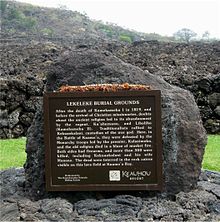Keaoua Kekuaokalani
| Keaoua Kekua-o-kalani | |
|---|---|

Memorial at Kuamoʻo
|
|
| Died | December 1819 Kuamoʻo |
| Spouse |
Manono II (probably others) |
| Father | Keliʻimaikaʻi |
| Mother | Kiʻilaweau |
Keaoua Kekua-o-kalani (sometimes known as Kaiwi-kuamoʻo Kekua-o-kalani) was a nephew of the king Kamehameha I, the chief from the Big Island of Hawaiʻi who had unified the Hawaiian islands.
He was the son of Kamehameha's younger brother Keliʻimaikaʻi and Kamehameha's half-sister Kiʻilaweau. After Kamehameha died in 1819, Keaoua rebelled against Kamehameha's successor, his son Kamehameha II. Keaoua's rebellion was brief; he was killed in battle about 21 December 1819.
His grandmother was Manono I, and his wife was Manono II.
After Kamehameha died, on 8 May 1819, power was officially assumed by Kamehameha's son Liholiho. Liholiho, at the urging of powerful female chiefs such as Kaʻahumanu, abolished the kapu system that had governed life in Hawaiʻi for centuries. Henceforth, men and women could eat together, women could eat formerly forbidden foods, and official worship at the stone platform temples, or heiaus, was discontinued. This event is called the ʻAi Noa, or free eating.
As the historian Gavan Daws points out (Daws, 1967, pp. 54–59), this was a decision taken by the chiefs, and it primarily affected the state religion. Commoners could still worship their family protective deities, their aumakua; hula teachers could make offerings to Laka and Big Island Hawaiians could make offerings to the goddess Pele.
Nonetheless, some of the chiefs felt that if they were to abandon the kapus and the services at the heiaus, they would lose the religious justification and support for their rule. Liholiho, they felt, was courting disaster, and must be opposed, lest he take down everyone with him.
Keaoua Kekuaokalani was a Big Island noble. He was the son of Kamehameha's younger brother and if Liholiho were to die or be overthrown, would have a good claim to the throne. He was outraged by the abandonment of the old sacred traditions and withdrew from the royal court, then staying at Kailua-Kona, on the Big Island, and retired to Kaʻawaloa at Kealakekua Bay. Many opponents of the ʻAi Noa joined him in his self-imposed exile and urged him to try for the throne, saying, "The chief who prays to the god, he is the chief who will hold the rule." (Kamakau, 1961, p. 226) Some of the Hawaiians living in Hamakua, on the north coast of the Big Island, rebelled outright and killed some soldiers sent against them. The situation was perilous.
...
Wikipedia
